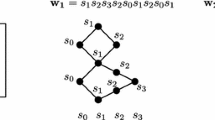Abstract
We provide a treatment of the ergodic properties of a noncommutative algebraic analogue of the dynamical system known as the Arnold ‘cat map’ of the two-dimensional torus. Here, the algebra of functions on the torus is replaced by its noncommutative analogue, formulated by Connes and Rieffel, which arises in the quantum Hall effect. Our main results are that (a) the system is mixing and, as in the classical case, the unitary operator, representing its dynamical map, has countable Lebesgue spectrum; (b) for rational values of the noncommutativity parameter, θ, the model is a K-system, in the algebraic sense of Emch, Narnhofer, and Thirring, though not in the entropic sense of Narnhofer and Thirring; (c) for irrational values of θ, except possibly for a set of zero Lebesgue measures, it is neither an algebraic nor an entropic K-system.
Similar content being viewed by others
References
Arnold, V. I. and Avez, A., Ergodic Problems of Classical Mechanics, Benjamin, New York, 1969.
Connes, A., C.R. Acad. Paris, Sér. A 290, 599 (1985); Connes, A. and Rieffel, M. A., Yang-Mills for noncommutative two-tori, in Operator Algebras in Mathematical Physics, Contemp. Math. 62, American Math. Soc. Providence, R.I., 1987.
Bellissard, J., K-theory of C *-algebras in solid state physics, in T. C.Dorlas, N. M.Hugenholtz, and M.Winnink (eds.), Statistical Mechanics and Field Theory, Springer, Berlin, Heidelberg, New York, 1986.
Emch, G. G., Comm. Math. Phys. 49, 191 (1976).
Narnhofer, H. and Thirring, W., Algebraic K-systems, Lett. Math. Phys. 20, 231 (1990).
Narnhofer, H. and Thirring, W., Comm. Math. Phys. 125 565 (1989).
Kolmogorov, A. N., Dokl. Acad. Sci. U.S.S.R. 119, 861 (1958).
Connes, A., Narnhofer, H., and Thirring, W., Comm. Math. Phys. 112, 691 (1987).
Narnhofer, H., Pflug, A., and Thirring, W., in Symmetry in Nature II, in Honour of V. A. Radicati di Brorolo, Scuola Normale Superiore, Pisa, 1989, p. 597.
Sinai, Ya. G., Russian Math. Surveys 25(2), 137 (1970).
Hannay, J. H. and Berry, M. V., Physica 1D, 267 (1980); Ford, J., Mantica, G., and Ristow, G. H., The Arnold cat: Failure of the correspondence principle.
Sakai, S., C * -Algebras and W * -Algebras, Springer, Berlin, Heidelberg, New York (1971).
Narnhofer, H., Dynamical entropy, quantum K-systems and clustering, in L. Accordi and W. von Waldenfels (eds.), Quantum Probability, Proc. 1988 Heidelberg Conference on Quantum Probability and Applications.
Benatti, F. and Narnhofer, H., Strong asymptotic Abelianness for entropic K-systems, Preprint.
Jones, V. F. R., Invent. Math. 72, 1 (1983).
Takesaki, M., Tomita's Theory of Modular Hilbert Algebras and its Applications, Lecture Notes in Math. No. 128, Springer, Berlin, Heidelberg, New York, 1970.
Author information
Authors and Affiliations
Additional information
Supported in part by Fonds zur Förderung der wissenschaftlichen Forschung in Österreich, Project No. P7101-PHY.
Rights and permissions
About this article
Cite this article
Benatti, F., Narnhofer, H. & Sewell, G.L. A non-commutative version of the Arnold cat map. Lett Math Phys 21, 157–172 (1991). https://doi.org/10.1007/BF00401650
Received:
Issue Date:
DOI: https://doi.org/10.1007/BF00401650




